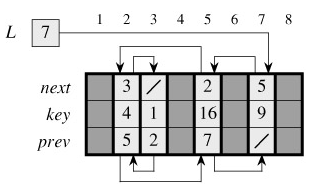Implementing Pointers And Objects
Implementing pointers and objects
How do we implement pointers and objects in languages, such as Fortran, that do not provide them? In this section, we shall see two ways of implementing linked data structures without an explicit pointer data type. We shall synthesize objects and pointers from arrays and array indices.
A multiple-array representation of objects
We can represent a collection of objects that have the same fields by using an array for each field. As an example, Figure 10.5 shows how we can implement the linked list of Figure 10.3(a) with three arrays. The array key holds the values of the keys currently in the dynamic set, and the pointers are stored in the arrays next and prev. For a given array index x, key[x], next[x], and prev[x] represent an object in the linked list. Under this interpretation, a pointer x is simply a common index into the key, next, and prev arrays.

In Figure 10.3(a), the object with key 4 follows the object with key 16 in the linked list. In Figure 10.5, key 4 appears in key[2], and key 16 appears in key[5], so we have next[5] = 2 and prev[2] = 5. Although the constant NIL appears in the next field of the tail and the prev field of the head, we usually use an integer (such as 0 or -1) that cannot possibly represent an actual index into the arrays. A variable L holds the index of the head of the list.
In our pseudocode, we have been using square brackets to denote both the indexing of an array and the selection of a field (attribute) of an object. Either way, the meanings of key[x], next[x], and prev[x] are consistent with implementation practice.
A single-array representation of objects
The words in a computer memory are typically addressed by integers from 0 to M - 1, where M is a suitably large integer. In many programming languages, an object occupies a contiguous set of locations in the computer memory. A pointer is simply the address of the first memory location of the object, and other memory locations within the object can be indexed by adding an offset to the pointer.
We can use the same strategy for implementing objects in programming environments that do not provide explicit pointer data types. For example, Figure 10.6 shows how a single array A can be used to store the linked list from Figures 10.3(a) and 10.5. An object occupies a contiguous subarray A[j ‥ k]. Each field of the object corresponds to an offset in the range from 0 to k - j, and a pointer to the object is the index j. In Figure 10.6, the offsets corresponding to key, next, and prev are 0, 1, and 2, respectively. To read the value of prev[i], given a pointer i, we add the value i of the pointer to the offset 2, thus reading A[i 2].

The single-array representation is flexible in that it permits objects of different lengths to be stored in the same array. The problem of managing such a heterogeneous collection of objects is more difficult than the problem of managing a homogeneous collection, where all objects have the same fields. Since most of the data structures we shall consider are composed of homogeneous elements, it will be sufficient for our purposes to use the multiple-array representation of objects.
Allocating and freeing objects
To insert a key into a dynamic set represented by a doubly linked list, we must allocate a pointer to a currently unused object in the linked-list representation. Thus, it is useful to manage the storage of objects not currently used in the linked-list representation so that one can be allocated. In some systems, a garbage collector is responsible for determining which objects are unused. Many applications, however, are simple enough that they can bear responsibility for returning an unused object to a storage manager. We shall now explore the problem of allocating and freeing (or deallocating) homogeneous objects using the example of a doubly linked list represented by multiple arrays.
Suppose that the arrays in the multiple-array representation have length m and that at some moment the dynamic set contains n ≤ m elements. Then n objects represent elements currently in the dynamic set, and the remaining m-n objects are free; the free objects can be used to represent elements inserted into the dynamic set in the future.
We keep the free objects in a singly linked list, which we call the free list. The free list uses only the next array, which stores the next pointers within the list. The head of the free list is held in the global variable free. When the dynamic set represented by linked list L is nonempty, the free list may be intertwined with list L, as shown in Figure 10.7. Note that each object in the representation is either in list L or in the free list, but not in both.